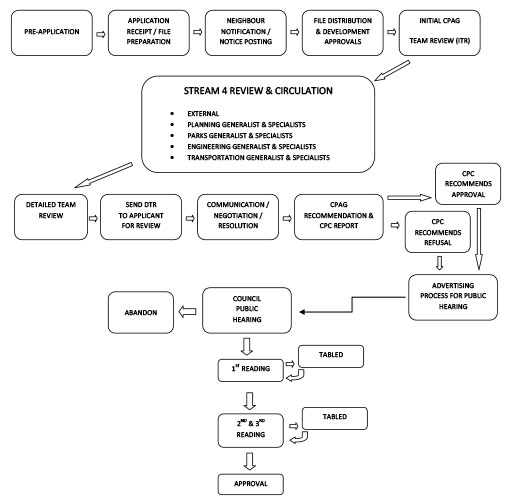A pair of Calgary councillors want to delay enacting the city’s proposed Guidebook for Great Communities until after the municipal election this fall, leaving those changes to the next council.

The guidebook, which would guide the redevelopment of communities within a local area plan, goes to council on Monday.
“Councillors should be transparent about the impacts that this planning document has for every single Calgarian,” Ward 11 councillor and mayoral candidate Jeromy Farkas said Wednesday.
“If they strongly believe in the benefits of this, they should be transparent about that, campaign on that, and after the election, they would have the mandate for these sweeping changes.”
Farkas is backing Ward 4 Coun. Sean Chu’s motion to postpone the guidebook until after the Oct. 18 general election.
Since January, the public has had two opportunities to make presentations on the guidebook to the city’s planning and urban development committee. Monday will be another opportunity.
Work on the guidebook began before the 2017 municipal election and has been part of a multi-term project led by Ward 9 councillor and former urban planner Gian-Carlo Carra that includes the Municipal Development Plan of 2009 and local area plans.
“The guidebook is a statutory document and it will influence the statutory documents of the local area plans going forward,” the mayoral hopeful said, flanked by citizens from Elboya/Brittania, University Heights and Meadowlark Park.
“When it comes to those local area plans, they will have the weight of law and influence what does come to council in the future.”
Calgary’s current mayor disagreed with that characterization.
“It’s actually a guidebook,” Naheed Nenshi said.
“It’s not a statutory plan. It’s not a law. It’s a guidebook.
“The problem that we’ve always had is when we go to do planning for older neighbourhoods and we want to do a redevelopment plan, and most neighbourhoods really want one, they’re long and they’re complicated and you start from scratch every time,” the mayor added, saying the guidebook would formalize best practices in neighbourhood redevelopment.
Like baking a cake
Nenshi had a culinary comparison for the contentious document.
“The guidebook is a cake recipe but it doesn’t tell any neighbourhood that they have to have a particular cake,” the mayor said. “When the neighbourhood is ready to do a plan, they can say, ‘Well, do we want a chocolate cake, a vanilla cake or red velvet cake?’ But all the cake recipes are in the guidebook.
“The only thing it does say is when you’re ready to do a plan, we’re baking a cake.”
Farkas said the city’s “one-size-fits-all approach is flawed.”
“I think that it’s very misguided to try to force these changes on Calgarians in a way that’s telling them how they should live their lives,” Farkas said. “The guidebook, to be clear, doesn’t impact zoning on the ground, at least today.

Get breaking National news
“But it does influence the future plans that come to council as well as the future applications that come up at council.”
One concern is the ability to tear down a house on a 50-foot lot and put in an eight-plex — something that is already possible under current rezoning regulations.
“What the guidebook does is it actually puts context around all of that, which I think is really the important thing,” Nenshi said. “It actually doesn’t change the zoning on a single lot in the entire city.”
The city’s land-use redesignation process involves city administration, community associations, the Calgary Planning Commissions and then approvals from committee and council.

Jyoti Gondek, Ward 3 councillor, chair of the city’s planning and urban development committee, and another mayoral hopeful, will be presenting an amendment at Monday’s council meeting, proposing a single-detached special policy area.
If approved by council, the amendment would have local area plans identify portions of communities that would stay as single-detached homes.
“When we had the public session of our last planning and urban development committee meeting (on Feb. 4), there seemed to be a lot of confusion around what would happen with the single-detached housing type,” Gondek told Global News.
“It became clear that people were concerned that it was being phased out.”
The proposed guidebook has identified two zones in the city for likely infill redevelopment — a collection of pre-war communities where that work is already underway and another set of communities where that work has or is expected to begin.
Gondek said citizen engagement on maintaining single-family homes comes during the local area planning stage after a community applies to the city for one.
Ward 6 Coun. Jeff Davison said there is a business-friendly argument for the guidebook as well.
“This is about looking at policy consolidation,” Davison said. “This is about looking at how do we reduce red tape and do so in a way that’s beneficial to the community?
“That said, we’ve heard that there’s a lot of people that are still confused by what’s going on.”
Misinformation a problem
The mayor and other councillors like Ward 7’s Druh Farrell, Davison, Gondek and Carra say there has been a lot of misinformation being circulated about the effects of the guidebook, like whether multi-storey, multi-family structures will start popping up in neighbourhoods that mostly have single-family homes.
One group calling itself Calgarians for Great Communities, which appears to be behind a prominently advertised website that outlines their concerns with the guidebook, did not respond to multiple interview requests from Global News.
Third-party advertiser (TPA) Alberta Proud and Ward 13 candidate Dan McLean have paid for Facebook advertising against the guidebook, with the TPA paying for a potential reach of one million people.
The City of Calgary has also paid for guidebook-related ads on the social media platform in 2020, advertising public information sessions and the preparation process.
Some 40,000 Calgarians have been consulted over 130 guidebook-specific consultations and 80 city planning events, according to Carra and Gondek.
Aging communities facing revitalization
The mayor noted that developed neighbourhoods have seen changes in their demographics over time, resulting in a couple of typical outcomes.
“Either the neighbourhood stagnates because there’s no redevelopment or the neighbourhood gentrifies and nobody can afford to live there anymore,” Nenshi said Tuesday.
“Thoughtful planning is how you prevent that from happening and how you think about how to create a neighborhood in the future that meets the needs of the people that live there now and the people that will live there in the future.”
Carra said part of the overall plan is to diversify neighbourhoods in many ways.
“The whole point of this is to have neighbourhoods that celebrate a greater diversity of opportunity and environment, lifestyle, as opposed to segregating the city into places where rich people live in, places where poor people live,” Carra told Global News.
“We want to build our city as complete, compact, mixed-use, walkable neighbourhoods, and those neighbourhoods are going to be various… and it’s going to make sense.
“We figure out where and how to do that through local area planning exercises with the toolbox that the guidebook provides us.”
–with files from Adam MacVicar, Global News











Comments